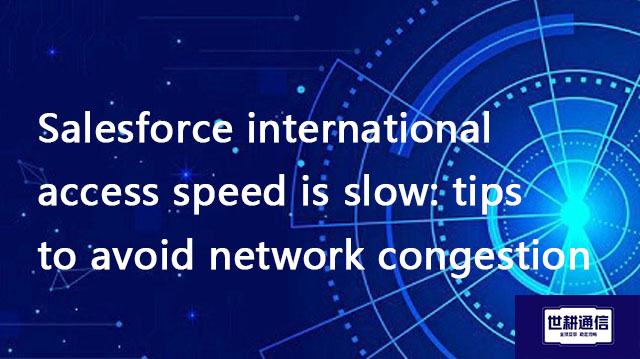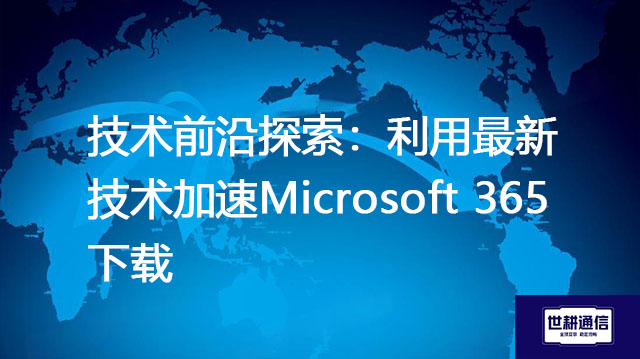Salesforce international access speed is slow: tips to avoid network congestion??? Solution//Global IPLC service provider of Shigeng Communication
一、As a global leader in Customer Relationship Management (CRM), Salesforce has over 100000 enterprise users in China. However, when domestic teams open the system to follow up with customers, they often encounter difficulties such as slow response times, page loading cycles, and even connection interruptions - which not only directly drag down business efficiency, but also invisibly push up operating costs. At its root, Salesforce's Asian nodes are mainly located in Japan, and domestic public network access requires complex cross-border routing, resulting in delays often exceeding 200ms and high packet loss rates. CRM data also poses security risks in public network transmission.
1. Root cause analysis of network congestion: not just geographical distance
Although geographical factors are the initial cause of delay, the actual bottleneck is hidden in deeper network architectures:
Physical distance and public network transmission loss: Data from Chinese to Japanese nodes needs to go through multi hop international routing, and each additional hop accumulates more latency and packet loss risks. The cross submarine cable congestion during peak hours of the public network will further exacerbate jitter (Jitter).
Hidden interference between security devices and local configurations: Enterprise firewalls or terminal security software may misjudge Salesforce traffic and actively restrict its connection; However, outdated browsers and plugin conflicts can significantly slow down front-end loading.
Data strategy and concurrency pressure: A large number of users synchronously executing report export or batch updates during peak business hours can trigger API traffic restrictions; Improper configuration when integrating third-party tools such as Hubspot and Zoho can exacerbate the situation.
2. Enterprise level acceleration solution: from dedicated lines to intelligent routing
Option 1: SD-WAN global backbone network+dedicated line direct connection (recommended to balance cost and performance)
This is currently the preferred architecture for most multinational corporations. Service providers (such as Guige Communication and LinkWAN) deploy private Point of Presence globally, connect to the backbone network through dedicated CPE devices, and dynamically connect to Salesforce Japan data centers using BGP protocol to achieve "last mile" optimization.
Core advantages: latency reduction of over 50%, packet loss rate suppressed below 0.1%, support for real-time monitoring and elastic scaling.
Applicable scenarios: Multi branch enterprises and users who need to accelerate SaaS applications such as Teams/Zoom simultaneously.
Option 2: Pure Dedicated Line Architecture (IPLC/MPLS)
IPLC dedicated line (international private leased line): provides a point-to-point physical isolation channel, completely bypassing the public network, and data is directly transmitted to Salesforce cloud. The delay can be controlled within 80ms, suitable for strong compliance industries such as finance and healthcare.
MPLS dedicated line: Optimized path selection through label switching technology, lower cost compared to IPLC, and supports multi protocol bearer, suitable for users with mature enterprise network architectures.
▶️ Suggestion for selection: For delay sensitive businesses such as Salesforce real-time analysis and high-frequency data synchronization, IPLC should be prioritized; If multiple applications such as ERP and video conferencing need to be taken into account, SD-WAN has better elasticity.
Option 3: Distributed Proxy Forwarding (Lightweight Alternative)
Deploy Nginx proxy server in the vicinity of Salesforce nodes (such as Japan), and transfer domestic requests through this:
Technical implementation: Domestic users → Japanese proxy server (high bandwidth) → Salesforce API
Case: A certain ToC platform serves over 2 million users and uses 4 Japanese proxy servers, reducing download latency from 3s to 400ms.
3. Terminal and configuration optimization: low-cost efficiency improvement techniques
Even without deploying dedicated lines, these measures can significantly improve the experience:
Network environment optimization
Replace Wi Fi with wired network to reduce packet loss caused by wireless interference
When upgrading enterprise bandwidth, ensure sufficient international export bandwidth (not just domestic bandwidth)
Local software and hardware settings
Upgrade to the latest version of Chrome/Firefox, disable non essential plugins (such as ad blockers that may accidentally block scripts)
Add *. salesforce.com to the firewall whitelist to prevent security software from accidentally intercepting it
Data Operations and Integration Management
Avoid performing large-scale operations from 9:00-11:00 (peak hours for domestic/Asia Pacific common time periods)
Regularly review third-party integration tools (such as Slack, SAP) and disable inefficient or high latency API connections
4. Quick Diagnostic Toolbox: Identifying the Source of Problems
When a card appears, three steps are taken to lock the bottleneck:
Ping Test Basic Quality
Execute ping - n 100 on the command line [instance name]. salesforce. com (e.g. na5. salesforce. com).
Key indicators: Optimization is required if packet loss rate>10% or average latency>150ms.
Traceroute analysis of routing hops
Run tracert [instance name]. salesforce.com and observe transcontinental jumps (such as from Shanghai → Singapore → Tokyo).
If the delay of a certain hop suddenly increases (such as 50ms → 300ms) or * * * timeout occurs, the problem node can be identified.
Monitoring platform status
Visit the Salesforce Trust site (trust. salesforce. com) to confirm if regional service fluctuations are causing the issue.
summarize
The cross-border access bottleneck of Salesforce is essentially a combination of public network unreliability and architectural limitations. For enterprises with high stability requirements, SD-WAN or IPLC dedicated lines are the fundamental solution, which can compress latency to within 100ms and achieve packet loss rates close to zero; Proxy solutions and terminal optimization are suitable as supplementary measures. It is recommended that companies first conduct self diagnosis through Ping/Traceroute, and then choose a solution based on the scale of their business - when 10 people x 1 hour are lost due to lag every day, the annual cost far exceeds the dedicated line investment.

二、Shigeng Communication Global Office Network Products:
The global office network product of Shigeng Communication is a high-quality product developed by the company for Chinese and foreign enterprise customers to access the application data transmission internet of overseas enterprises by making full use of its own network coverage and network management advantages.
Features of Global Application Network Products for Multinational Enterprises:
1. Quickly access global Internet cloud platform resources
2. Stable and low latency global cloud based video conferencing
3. Convenient and fast use of Internet resource sharing cloud platform (OA/ERP/cloud storage and other applications
Product tariff:
Global office network expenses | Monthly rent payment/yuan | Annual payment/yuan | Remarks |
Quality Package 1 | 1000 | 10800 | Free testing experience for 7 days |
Quality Package 2 | 1500 | 14400 | Free testing experience for 7 days |
Dedicated line package | 2400 | 19200 | Free testing experience for 7 days |






